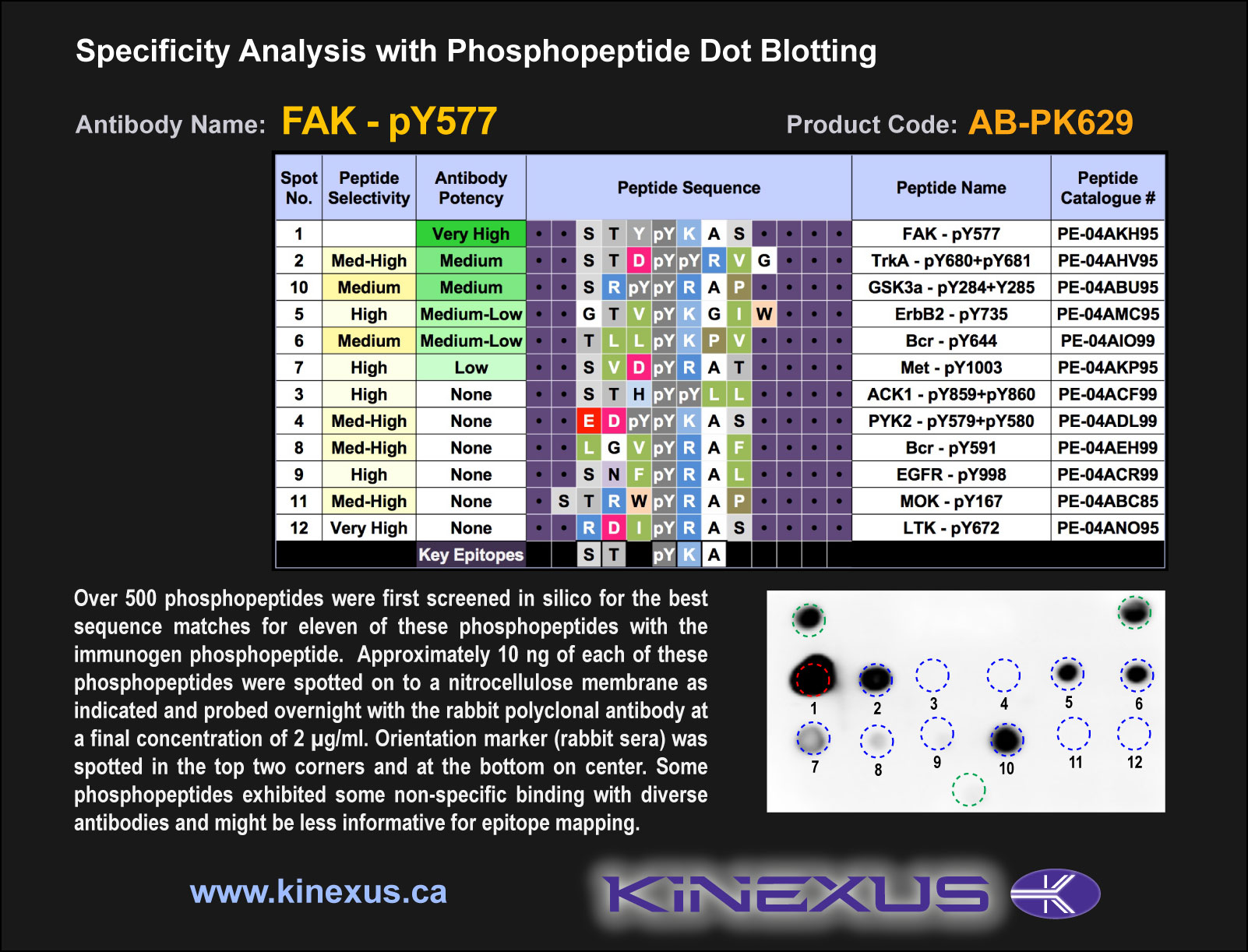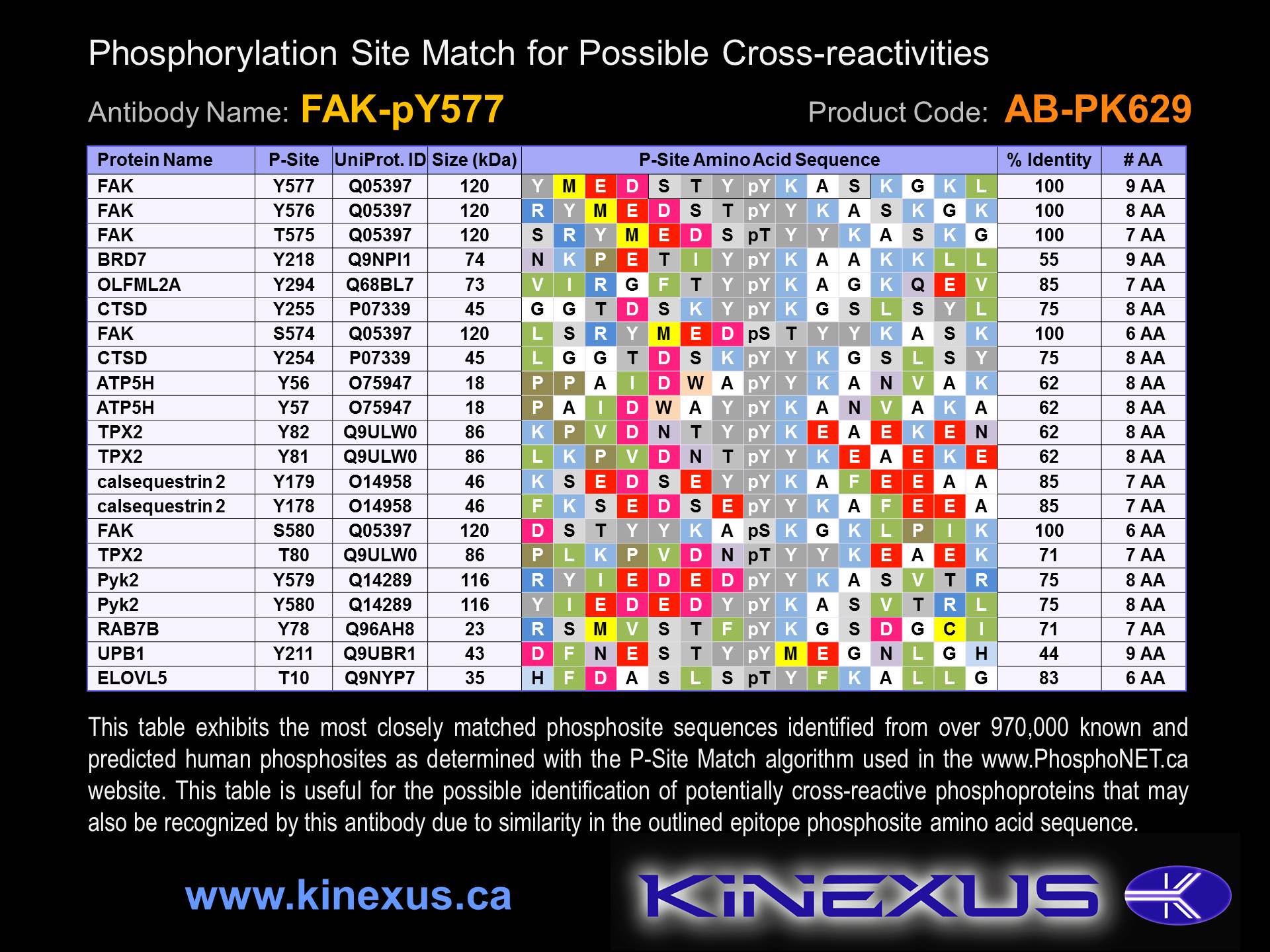Product Name: FAK-pY577
Product Number: AB-PK629
| Size: | 25 µg | Price: | 89.00 | |
| $US |
Target Full Name: Focal adhesion protein-tyrosine kinase
Target Alias: FADK1; FAK1; pp125FAK; FRNK; Protein-tyrosine kinase 2; PTK2; CCDS6381.1; ENSG00000169398
Product Type Specific: Protein kinase phosphosite-specific antibody
Antibody Code: PK629
Antibody Target Type: Phosphosite-specific
Antibody Phosphosite: Y577
Protein UniProt: Q05397
Protein SigNET: Q05397
Antibody Type: Polyclonal
Antibody Host Species: Rabbit
Target Alias: FADK1; FAK1; pp125FAK; FRNK; Protein-tyrosine kinase 2; PTK2; CCDS6381.1; ENSG00000169398
Product Type Specific: Protein kinase phosphosite-specific antibody
Antibody Code: PK629
Antibody Target Type: Phosphosite-specific
Antibody Phosphosite: Y577
Protein UniProt: Q05397
Protein SigNET: Q05397
Antibody Type: Polyclonal
Antibody Host Species: Rabbit
Antibody Immunogen Source: Human FAK (PTK2) sequence peptide Cat. No.: PE-04AKH95
Antibody Immunogen Sequence: STY(pY)KAS(bA)C
Antibody Immunogen Description: Corresponds to amino acid residues S574 to S580; In protein kinase catalytic domain activation T-loop between subdomains VII and VIII.
Antibody Immunogen Sequence: STY(pY)KAS(bA)C
Antibody Immunogen Description: Corresponds to amino acid residues S574 to S580; In protein kinase catalytic domain activation T-loop between subdomains VII and VIII.
Production Method: The immunizing peptide was produced by solid phase synthesis on a multipep peptide synthesizer and purified by reverse-phase hplc chromatography. Purity was assessed by analytical hplc and the amino acid sequence confirmed by mass spectrometry analysis. This peptide was coupled to KLH prior to immunization into rabbits. New Zealand White rabbits were subcutaneously injected with KLH-coupled immunizing peptide every 4 weeks for 4 months. The sera from these animals was applied onto an agarose column to which the immunogen peptide was thio-linked. Antibody was eluted from the column with 0.1 M glycine, pH 2.5. Subsequently, the antibody solution was neutralized to pH 7.0 with saturated Tris.This antibody was also subject to negative purification over phosphotyrosine-agarose.
Antibody Modification: Unconjugated. Contact KInexus if you are interest in having the antibody biotinylated or coupled with fluorescent dyes.
Antibody Modification: Unconjugated. Contact KInexus if you are interest in having the antibody biotinylated or coupled with fluorescent dyes.
Antibody Concentration: 1 mg/ml
Storage Buffer: Phosphate buffered saline pH 7.4, 0.05% Thimerasol
Storage Conditions: For long term storage, keep frozen at -40°C or lower. Stock solution can be kept at +4°C for more than 3 months. Avoid repeated freeze-thaw cycles.
Product Use: Western blotting | Antibody microarray
Antibody Dilution Recommended: 2 µg/ml for immunoblotting
Antibody Potency: Very strong immunoreactivity with immunogen peptide on dot blots.
Antibody Species Reactivity: Human
Antibody Positive Control: The observed molecular mass of the processed target protein on SDS-PAGE gels is reported to be around 105-115 kDa.
Storage Buffer: Phosphate buffered saline pH 7.4, 0.05% Thimerasol
Storage Conditions: For long term storage, keep frozen at -40°C or lower. Stock solution can be kept at +4°C for more than 3 months. Avoid repeated freeze-thaw cycles.
Product Use: Western blotting | Antibody microarray
Antibody Dilution Recommended: 2 µg/ml for immunoblotting
Antibody Potency: Very strong immunoreactivity with immunogen peptide on dot blots.
Antibody Species Reactivity: Human
Antibody Positive Control: The observed molecular mass of the processed target protein on SDS-PAGE gels is reported to be around 105-115 kDa.
Antibody Specificity: Very high
Antibody Cross Reactivity: No significant cross-reactive proteins detected in A431 cells, HeLa cells and sea star oocytes, except for a 75 kDa protein that was observed in FBS-treated A431 cells.
Related Product 1: FAK-pY577 blocking peptide
Related Product 2: FAK-pY397 phosphosite-specific antibody (Cat. No.: AB-PK627)
Related Product 3: FAK-pY576+pY577 phosphosite-specific antibody (Cat. No.: AB-PK628)
Related Product 4: FAKSubtide - FAK protein kinase substrate peptide
Antibody Cross Reactivity: No significant cross-reactive proteins detected in A431 cells, HeLa cells and sea star oocytes, except for a 75 kDa protein that was observed in FBS-treated A431 cells.
Related Product 1: FAK-pY577 blocking peptide
Related Product 2: FAK-pY397 phosphosite-specific antibody (Cat. No.: AB-PK627)
Related Product 3: FAK-pY576+pY577 phosphosite-specific antibody (Cat. No.: AB-PK628)
Related Product 4: FAKSubtide - FAK protein kinase substrate peptide
Scientific Background: FAK (PTK2) is a protein-tyrosine kinase of the TK group and FAK family. It is a non-receptor kinase that regulates a variety of cell processes, including cell migration, adhesion, spreading, actin cytoskeletal reorganization, formation/disassembly of focal adhesions, progression through the cell cycle, cell proliferation, and apoptosis. In addition, the FAK protein is required for the proper development of the heart, skeleton, and nervous system. Phosphorylation of T397 increases phosphotransferse activity, induces interaction with FAK and SOCS1, and inhibits interaction with PIK3R2 and Src. Phosphorylation of Y576 and Y577 increases phosphotransferase activity. Phosphorylation of Y861 increases phosphotranserase activity and induces interaction with ITGB5 and p130 Cas. Phosphorylation of Y925 induces interaction with Grb2. Phosphorylation at S722 inhibits FAK binding to the adapter protein p130Cas. FAK appears to be an oncoprotein (OP). A role for FAK in cancer cell migration and motility has been demonstrated for several human cancer types. Knockdown of FAK expression in a human gastric adenocarinoma cell line resulted in the impairment of cancer cell spreading and elongation. In animal studies, deletion of the FAK gene in mice prevented papilloma formation and inhibited the progression of malignancy in pre-formed benign tumours, indicating an oncogenic role for the FAK protein. Additionally, FAK gene deletion was associated with a reduction in keratinocyte migration and increased keratinocyte cell death. Therefore, FAK was concluded to modulate the formation of benign tumours and their subsequent malignant conversion. In 39 hepatocellular carcinoma (HCC) cell lines analyzed for copy number expression, increased copy number was observed at the FAK locus and correlated strongly with expression level of the FAK protein as well as an increased tumour size (>5 cm).
Figure 1. Epitope mapping of FAK-pY577 antibody with similar phosphopeptides on dot blots.
Figure 2. Identification of phosphosites related to FAK-pY577.
© Kinexus Bioinformatics Corporation 2017



